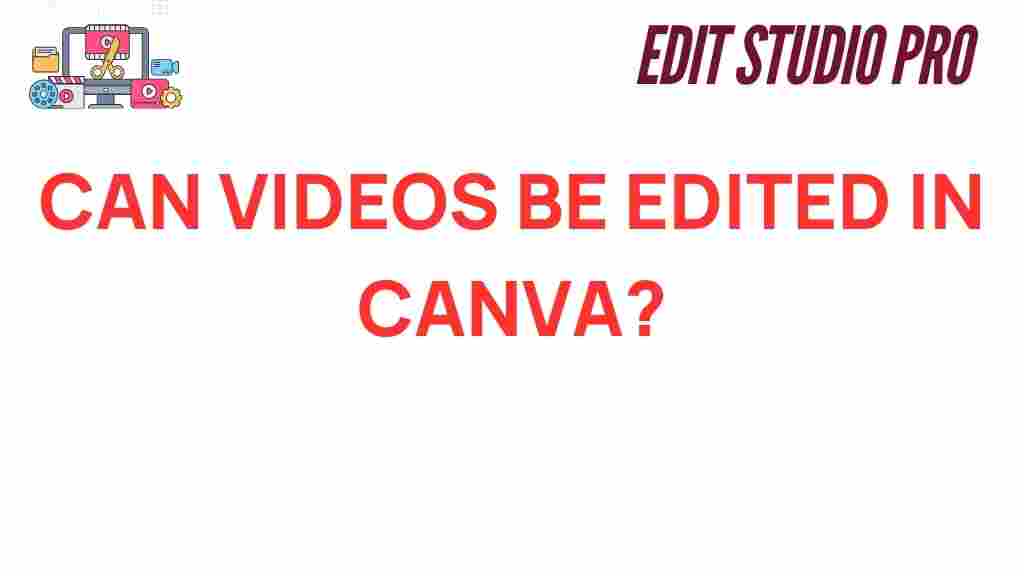Can Videos Be Edited in Canva? Unveiling the Power of This Tool
In the world of content creation, having effective design tools at your disposal is essential. One of the most popular platforms for video editing and graphic design is Canva. This user-friendly tool has revolutionized the way creators approach their creative projects. In this article, we will explore whether videos can be edited in Canva, the features it offers, and how it can enhance your multimedia projects.
What is Canva?
Canva is an online design platform that allows users to create a wide range of visual content, from social media graphics to presentations and, importantly, videos. With its intuitive interface and extensive library of templates and assets, Canva has become a go-to solution for professionals and amateurs alike.
The Rise of Video Content
Over recent years, video content has become a dominant force in multimedia. Platforms like YouTube, Instagram, and TikTok are testaments to the power of engaging video. As a result, the demand for video editing tools has surged, making it crucial for creators to find accessible and efficient solutions.
Canva addresses this need with its video editing capabilities, making it easier for anyone to craft compelling video content without requiring extensive technical skills.
Editing Videos in Canva: A Step-by-Step Guide
Now that we understand what Canva is and its relevance in the current digital landscape, let’s dive into the process of editing videos within this platform. Follow these steps to start your journey into video editing with Canva:
Step 1: Sign Up or Log In
If you don’t already have a Canva account, visit the Canva website and sign up for free. If you have an account, simply log in to access the platform.
Step 2: Choose a Video Template
Once you’re logged in, you can begin by selecting a video template. Canva offers a variety of pre-designed templates that are perfect for different occasions, such as:
- Social Media Videos
- Promotional Videos
- Educational Content
- Event Recaps
Browse through the options and select one that fits your project.
Step 3: Upload Your Video Clips
To personalize your video, you can upload your own video clips. Click on the “Uploads” tab in the left sidebar, and then select “Upload media.” You can upload videos from your computer, Dropbox, or Google Drive.
Step 4: Drag and Drop Your Clips
After uploading your clips, simply drag and drop them into the template. Canva allows you to easily rearrange the clips by moving them around on the timeline.
Step 5: Edit Your Video
Once your clips are in place, you can start editing them. Canva offers a range of editing features:
- Trimming: Adjust the length of your video clips to keep only the essential parts.
- Transitions: Add smooth transitions between clips to enhance the viewing experience.
- Text: Overlay text to convey messages, titles, or captions. Choose from various fonts and styles.
- Music: Integrate background music by selecting from Canva’s extensive audio library or uploading your own.
- Filters and Effects: Apply filters or effects to give your video a unique look.
Step 6: Preview Your Video
Once you’ve made all the necessary edits, click on the play button to preview your video. This allows you to see how your edits flow together and make any final adjustments.
Step 7: Download and Share
When you’re satisfied with your video, it’s time to download it. Click on the “Download” button located at the top right corner. Choose your desired video format (MP4 is recommended) and resolution, then click on “Download” again to save your video to your device.
Step 8: Share Your Video
Canva also allows you to share your video directly to social media platforms or via a shareable link. This feature simplifies the process of distributing your content to your audience.
Troubleshooting Common Issues
While Canva is user-friendly, users may encounter some common issues. Here are some troubleshooting tips:
- Slow Loading: If Canva is loading slowly, ensure your internet connection is stable. You can also try clearing your browser cache.
- File Size Limitations: If your video upload fails, check the file size. Canva has specific limits on file sizes; keeping videos under 250MB is recommended.
- Audio Issues: If your audio isn’t playing, make sure the audio track is properly added to the timeline and not muted.
- Compatibility Issues: Ensure that your browser is up to date. Canva works best on Google Chrome, Firefox, and Safari.
Why Choose Canva for Video Editing?
Canva stands out among design tools for various reasons. Here are some key benefits:
- User-Friendly Interface: Canva’s drag-and-drop functionality makes it easy for anyone to start editing videos, regardless of technical skill.
- Extensive Library: With thousands of templates, images, and audio tracks, users have endless creative possibilities.
- Access Anywhere: Being an online platform, Canva can be accessed from anywhere, making it convenient for on-the-go editing.
- Collaboration Features: Canva allows teams to work together on projects, making it ideal for collaborative content creation.
Conclusion
In conclusion, Canva is not only a powerful tool for graphic design but also a robust platform for video editing. With its user-friendly features and extensive resources, anyone can create stunning videos for their creative projects. Whether you’re a seasoned professional or a beginner, Canva makes the process of online editing accessible and enjoyable.
So, if you’re looking to enhance your content creation efforts, give Canva a try. You might just discover the perfect solution for your video editing needs!
For more tips on video editing and multimedia content creation, check out our comprehensive guide on mastering video content.
This article is in the category Software & Tools and created by EditStudioPro Team
